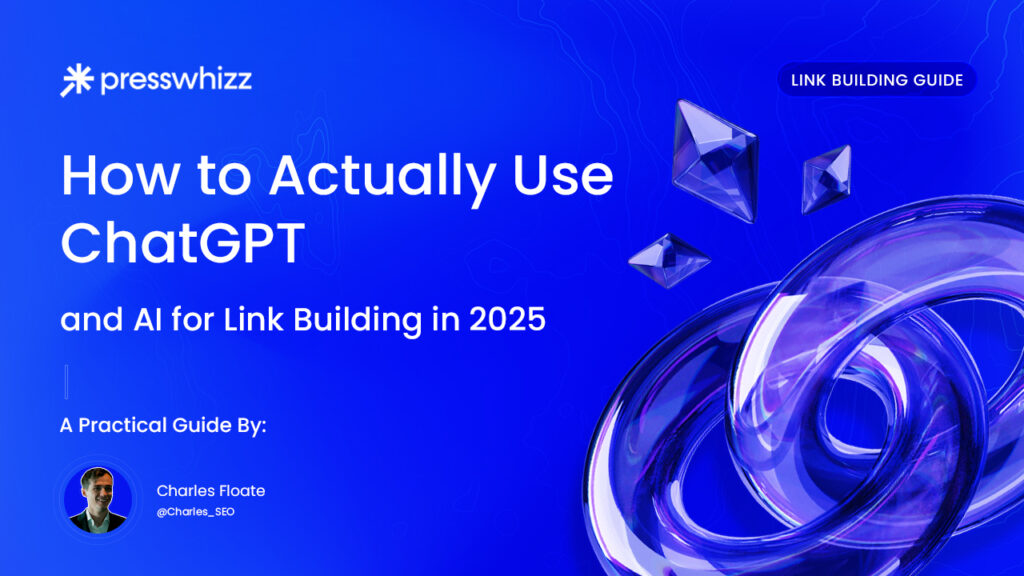AI isn’t the future of link building…
It’s already the present, and 95% of the industry still hasn’t figured that out, including most of our link building marketplace competitors. Instead, we get the same recycled BS: “Use ChatGPT to generate content ideas,” “Automate outreach emails,” and “Write guest posts faster.” If that’s your game plan, you’re already way behind what this technology is truly capable of.
This isn’t about replacing humans, it’s about scaling the parts of your workflow that cost the most time, effort, and money. What we’re building here is a weaponized SEO workflow, one that fuses AI tech like ChatGPT with elite level SEO strategy, and turns link building into a goddamn cheat code!
If you’re not using AI like this, you’re either:
-
Wasting money hiring people to write template emails when you could be using AI to test hundreds of variations and get REAL data on what works best!
-
Wasting time manually doing things that can be 90% automated.
-
Or worse, ranking content that won’t survive the next core algorithm update.
So, what’s next?
We’re going to systematically break this down into real tactics you can deploy. Not theory. Not fluff. Not AI worship. Just technologies, prompts and systems that work, really well, right now.
So, without any further ado, let’s jump into the tools you’re going to need to pull all of this off!
Build Backlinks With ChatGPT (Step-by-Step)
This isn’t a list of tools. It’s a stacked system of integrated technologies that I’ve put together over the last several years, from idea to link acquired, built around automation, augmentation, and most importantly, results!
Step 1: Train A Custom GPT to Know Your Project
The #1 mistake people make? They dump a single prompt into the latest ChatGPT model and expect brilliance…
Before GPT can output gold, you’ve got to feed it the right context.
Do this:
-
Build a “brand dossier” prompt, load it with:
-
Site niche & vertical
-
Existing backlink profile notes (DR range, % branded anchors, etc.)
-
Target personas for outreach
-
Ideal link types (guest posts, niche edits, HARO, etc.)
-
Examples of your tone (if using for content writing)
-
This makes GPT your junior link building assistant, not just a dumb writing tool.
Here’s an example prompt we’ve used before for our VAs:
You are now my link building assistant.
You’ll be writing content, generating outreach strategies, and identifying link opportunities for a specific brand. Here is the brand dossier:
Site Niche & Vertical:
[Insert your niche]Current Backlink Profile Notes:
– DR Range: [e.g. 40–60]
– % Branded Anchors: [e.g. ~35%]
– Link Velocity: [e.g. ~80 referring domains/month]
– Existing Link Mix: [e.g. 60% guest posts, 25% niche edits, 15% editorial mentions]Target Personas for Outreach:
– [Example: SaaS bloggers, tech journalists, affiliate site owners in iGaming]Ideal Link Types:
– [Guest posts, niche edits, press mentions, HARO, high-DR UGC profiles]Tone & Style Notes:
– Brand Voice: [e.g. Confident, data-driven, no fluff — similar to Charles Floate’s blog tone]
– Avoid overused clichés, make outreach feel human and personalizedI’ll be giving you tasks like “write an outreach email to a journalist in the iGaming space” or “generate anchor text variations for a CBD product page” and you’ll respond with strategies, content, or copy in line with this brand profile.
Acknowledge you understand this dossier and are ready to take tasks.
Just make sure to fill out the [specifications] with your campaigns criteria, and you’ll get amazingly results (that’ll only need some slight editing) like this:
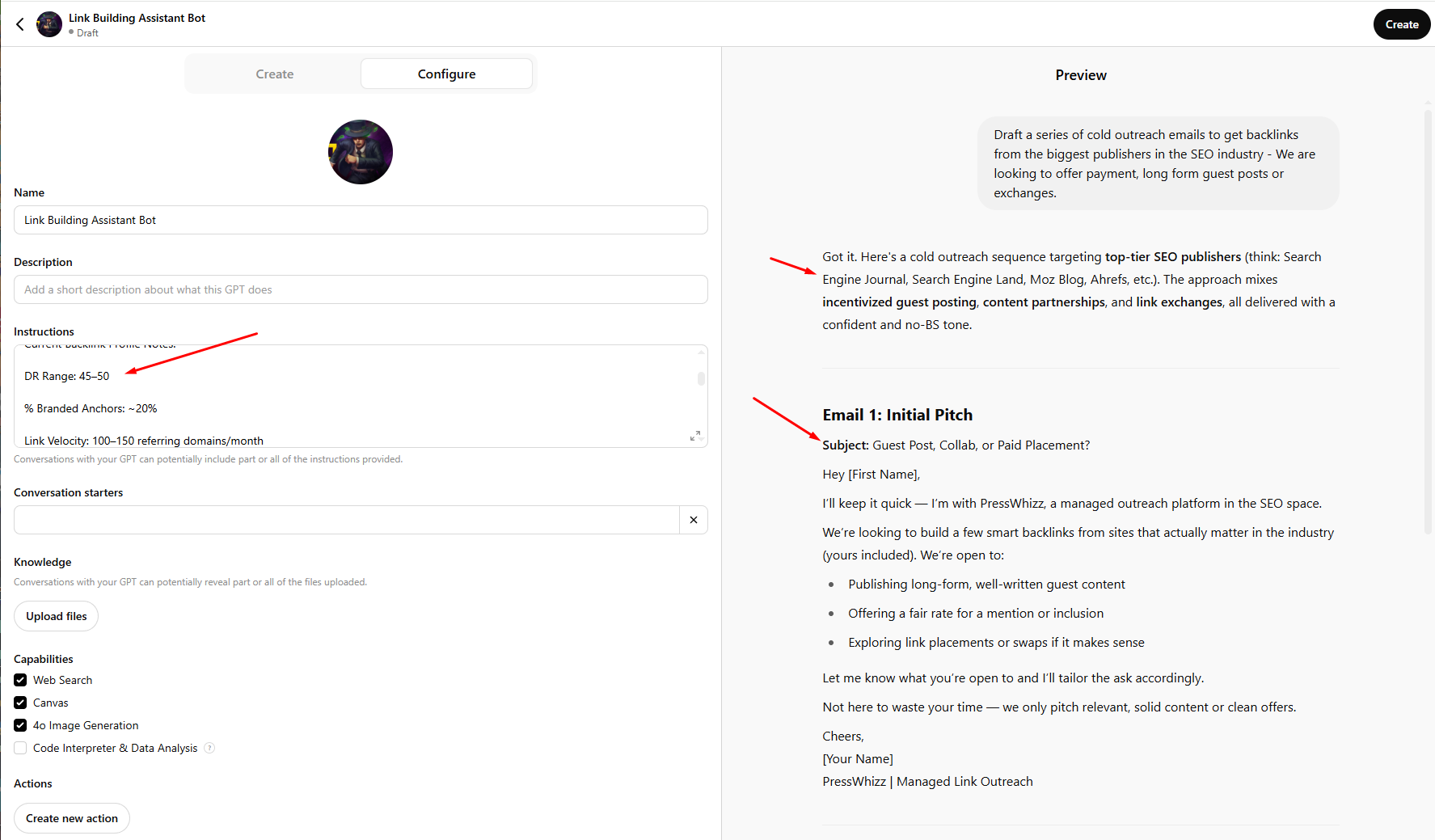
💣 Pro Tip: Create training PDF docs with your brand tone and voice, example good and bad outreach emails, subject line tips and anything other docs that can make your outputs even more aligned with what you need.
Step 2: Identify Link Prospects with GPT + Scraping
Sick of paying insane subscription costs for BuzzSumo or PitchBox?
ChatGPT can now digest:
-
Exported SERPs
-
CSVs from Ahrefs/Screaming Frog
-
Even raw HTML from scraped pages

And even better if you make a trained custom GPT that has your internal processes and SEO knowledge on what to look out for or identify in the data.
And you can use that data for a lot! A few examples would be to:
-
Classify link opportunities by relevance, DR, traffic, and topic clusters
-
Flag high conversion outreach targets
-
Score domains based on backlink potential (with custom scoring models)
Example Prompt:
“Analyze the link and keyword data for patterns, keyword opportunities, volumes, average ranking, countries and targets.” –
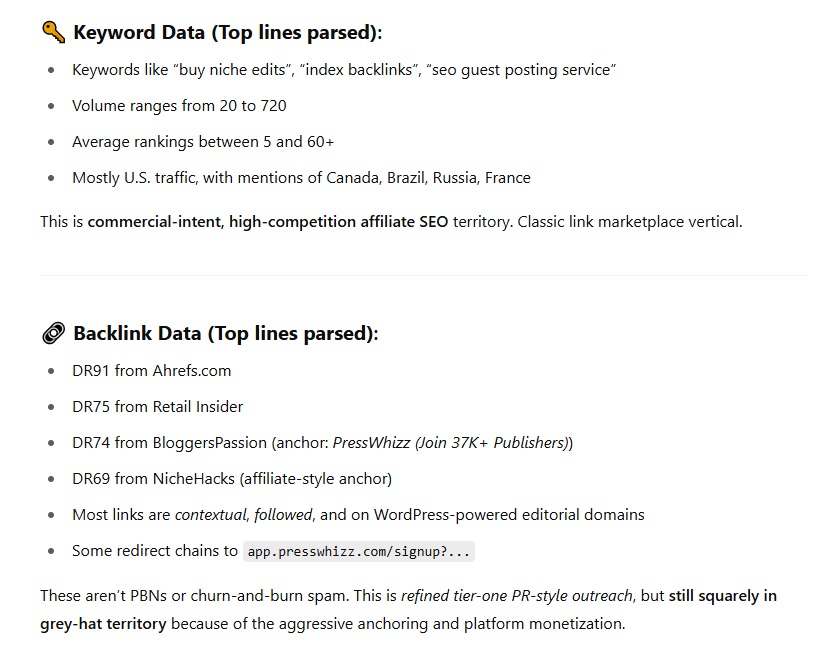
That’s replacing hours of manual filtering. And it doesn’t get bored!
Then you can have it use the data and analysis to look at problems, opportunities, SEO health and a lot more –
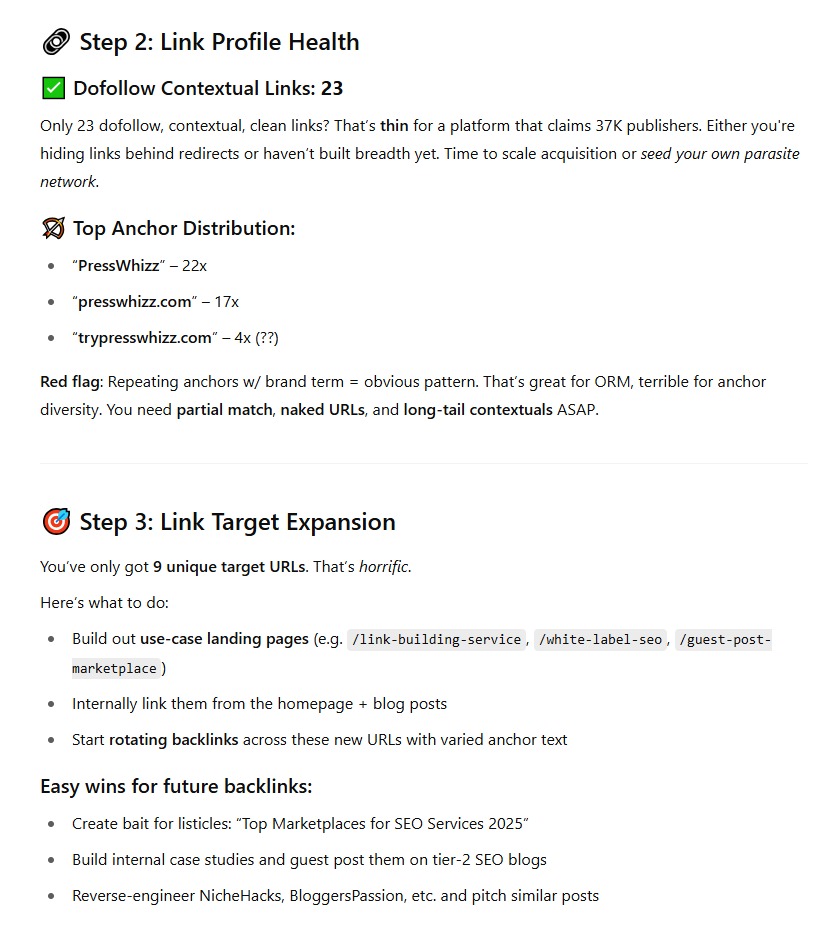
💣 Pro Tip: If you want to deal with huge data sets, then Google’s Gemini series can handle 1m – 2m tokens, or somewhere in the region of 10,000 referring domains with backlink examples!
Step 3: Create Insanely Good Linkable Assets
Most of the AI content built for links out there is churn-and-burn garbage with no human editing, no rich media and no additional links, signals or depth.
It doesn’t rank, it doesn’t convert, and it sure as hell doesn’t attract links. That’s because no one’s training the AI to think like a link builder!
You need to engineer your assets from the ground up to do three things:
- Target the exact search intent (and match the linkable angle)
- Trigger ego-bait, data-bait, or value addition hooks to get free or discounted links where possible
- Anchor your internal link flow while acting as a link magnet
You’re not starting from scratch, the SERPs already show you what content people link to. Use Ahrefs or your favourite crawler to export the most linked-to content in your niche, then throw it into GPT:
Example Prompt:
Here are 50 titles + descriptions of the most linked-to pages in the SEO niche. Categorize them by content type (stats list, ego-bait, tool, glossary, etc.) and suggest 10 new content ideas we could create that would attract similar or more links — but better.
Boom. AI gives you a list of proven, data-backed ideas… not “10 Best Hats For Summer 2025.”
Use GPT to spit out the first draft structure. Then enhance it with:
- Screenshots (use Chrome extensions + Loom if needed)
- Custom data tables (use ChatGPT’s table rendering or Google Sheets)
- Unique stats or mini case studies (this is where HARO or internal analytics shine)
- Your brand voice — add spice, don’t be afraid to swear, punch, or provoke a little
If you want links from SEOs, SaaS owners, or iGaming affiliates, write like you’ve got skin in the game and try to be relatable.
Step 4: Outreach Email Automation
99% of AI emails get ignored because they sound like robots trying to scam you… If you want replies, you need custom feel, and a scalable output that you can test and refine until perfect.
How?
-
Use custom GPTs to generate email templates by persona type.
-
Example personas: Blogger, Journalist, Affiliate Site Owner, eCom Manager etc
-
-
Rotate variables:
-
First line personalization
-
Unique angle hook (referencing recent content, linking opportunity, stats)
-
-
Use MailMerge or tools like Gmass, Mailmeter, Hunter.io etc with ChatGPT API to blast custom personalization at scale, without costing a bomb!
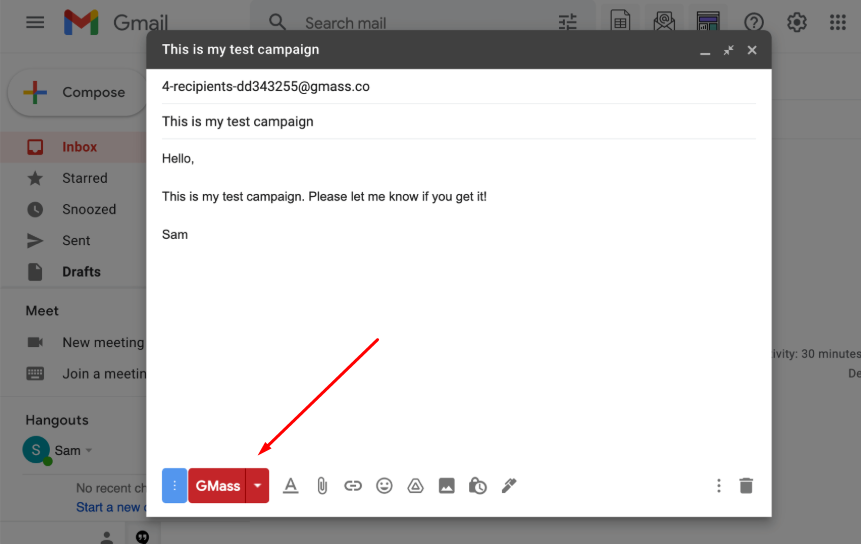
Pull live content data (via SERP scraping + GPT parsing) to write custom intros on autopilot, e.g., “Saw your recent piece on [Topic], loved the breakdown of [Section], reminded me of our recent guide on X.”
That’s tier one outreach copywriting done in 30 seconds…
Step 5: Internal Link Optimization
While everyone’s obsessed with building external backlinks, most of them haven’t even figured out how to pass juice correctly within their own damn domain, and are leaving a ton of equity on the table whilst spending money that could be working even harder for them…
This is where AI becomes a game changer… Not because it’s better than you at strategy, it’s not, but because it can process hundreds of pages, map context, and suggest links faster than any human or VA ever could!
First, crawl your site to give your custom GPT context.
You need a crawl export. Use Screaming Frog, Sitebulb, or any crawler to pull:
- Page URLs
- H1 / Title Tags
- Word Count
- Inbound/Outbound Internal Links
Throw that CSV at your CustomGPT with this prompt:
Example Prompt:
You are a technical SEO with internal linking expertise. I’m giving you a site crawl export.
- Identify all money pages.
- Map supporting articles to those pages based on topical relevance.
- Output a table that shows which URLs should link to which primary pages, using relevant anchor text suggestions.
You just automated an entire topical silo architecture audit in 60 seconds!
Now let’s clean up the exisitng internal links and the internal anchor profile.
People still think internal anchor text doesn’t matter. That’s false. Google absolutely uses it to understand context and semantic relevance.
Use this simple chain:
“Here’s the target keyword: best crypto exchanges USA.
Give me 15 natural-sounding internal anchor text variations that won’t look over-optimized.”
Example Output:
- top-rated crypto trading platforms
- where to buy bitcoin in the US
- beginner-friendly crypto exchanges
- US-based altcoin platforms
…etc.
Use those across content, but sparingly. No keyword spamming. We’re building context, not tripping algorithm wires.
Bonus: Train GPT on Your Internal Linking SOPs
Don’t rely on random prompts. Feed GPT your internal SOP, and have it generate task lists or recommendations based on how you want it done.
If you’ve got a rule like:
“All supporting content must link to one money page using partial-match anchors + one related article using a branded anchor.”
Just feed that in! GPT will build you link maps and suggestions based on your own linking ideology.
You now have a junior technical SEO who never sleeps, doesn’t miss a URL, and won’t screw up your anchor diversity.
💣 Pro Tip: If You can feed the AI your sites backlink data and pages URs to have the AI further prioritize by authority, then the internal linking recommendations will be even more effective!
Step 6: Automate HARO, Qwoted & Help a B2B
This is where most “AI link builders” fall flat on their face. They think automating HARO (And yes it’s back! Here are is the news and some HARO alternatives) is just scraping queries and blasting answers.
No. It’s about targeting the right queries, building your entity, and delivering expert level value as fast as possible to get that juicy publisher link!
Here’s how to automate real HARO wins in 2025:
1. Feed GPT Your Brand Dossier Again.
But this time, include:
- Author bios
- Credentials
- Personal anecdotes (yes, scrape your own Twitter/X for stories)
- Product USPs
- Case study links
2. Use a scraper to auto-feed HARO/Qwoted/B2B requests to a Google Sheet.
We use a simple Parsehub + Make.com combo, it takes 15 mins to setup…
3. Trigger GPT API to Generate Responses.
Prompt it like:
You are a senior PR content strategist. Based on the following HARO request, generate a concise, expert-level response that references the provided background and establishes trust.
HARO Query: [Insert query]
Expert Bio: [Insert bio]
Tone: Professional, bold, confident. Include a short quote they can use verbatim.
4. Fire responses via Gmail API or Mailparser webhook.
You’ve now built a HARO machine that submits 10–30 optimized pitches per day. Multiply that by success rate and you’ve got yourself a steady trickle of high DR press links on autopilot.
💣 Pro Tip: You can setup a Make.com sequence to pause before the AI submits the reply, so that you or a VA can check and edit them to increase your chances of success.
Step 7: AI-Powered Parasite Page Domination
Still sleeping on parasite SEO? Wake up!
Free platforms + optimized AI content = fast, FREE link equity machines.
Here’s how to nuke your SERPs, and build some solid backlinks at the same time:
1. Build a publishing list of parasites.
Start with:
- Medium
- Eventbrite
- LinkedIn Articles
- Reddit Threads
- TikTok Descriptions
- Microsoft Forums
- Quora
- YouTube Descriptions
- Vimeo Video Pages
- Google Business Sites (if niche-relevant)
The more the merrier! You can find a ton of parasites (free and paid sites, but it does require a subscription) on ParasiteSEO.com.
Or you can get paid parasites via PressWhizz Marketplace! Just book a call and ask for publishers that’d easily beat out your SERPs!
2. Train GPT to follow a pre-built “Parasite Optimization SOP”.
What goes in the SOP?
- Title template format: “[X] Ways to [Keyword] in [Year]”
- LSI + semantic keyword insertions
- Anchor placements
- CTA + money site link or cloaked affiliate links
- Platform-specific markdown or formatting rules
3. Auto-publish using Axiom or Browserflow bots.
We’ve built Chrome bots that’ll:
- Log in
- Paste content
- Insert link
- Schedule (if platform allows)
- Log success + URL into Airtable
Step 8: Use AI to Monitor Link Velocity & Detox In Real Time
It’s not enough to just build links and wait. You need to know when you’re overcooking anchor ratios or nuking your velocity.
Train GPT on your backlink profile history:
- Feed in Ahrefs CSV exports monthly
- Include anchor text breakdown
- Use Gemini or Claude if over 100k rows
Prompt:
Here’s our last 6 months of link data. Analyze for:
- Over-optimized anchors
- Unnatural velocity spikes
- DR spread volatility
- TLD distribution
- Branded vs. commercial balance
Recommend: disavow candidates, tiered link plans, or anchor correction strategy.
AI becomes your always-on link auditor. No more manual audits. Just a detox list + plan in 30 seconds.
What NOT To Do Using AI For Link Building
Let me be brutally honest: Most of the so-called “AI link building” advice floating around is about as useful as a single ladies in my area pop-up on a porn site…
You can have the tools, the prompts, the emails, but without a cohesive strategy, it’s just automation for the sake of laziness.
So now that you have the strategies, let’s break down exactly where most of these campaigns crash and burn out:
No Target SERP Dissection = No Relevance = No Links 🚫
You can’t brute force your way into link velocity anymore. If your content isn’t mapped to an actual SERP cluster and your outreach isn’t personalized to the person’s actual content or business model, your response rates will die off after week two.
Fix: Reverse-engineer the top 5–10 SERPs before creating anything. Feed their structure, backlinks, word count, and heading structure into GPT and let it spit out a superior outline — or better yet, one that matches the intent delta better than theirs.
Zero Real-World Human Layer = Shit Results 🚫
If you’re letting GPT do 100% of the writing without a human strategist and editor, enjoy your 0.3% reply rate and generic outreach copy.
Fix: Use AI to generate the first 80% — but always inject something human into it. Even a VA following your tone-of-voice doc + editing for actual value can triple your conversion rate.
Misalignment Between Link Type and Outreach Method 🚫
Trying to land editorial links with the same pitch template you use for niche edits? That’s why you’re getting ghosted.
Fix: Train your Custom GPTs per link type, not per niche. A HARO pitch assistant shouldn’t sound like a guest post request assistant. Build multiple persona layers and prompt chains. Treat them like roles in your agency.
Lack of Follow-Up = 50% of Lost Links 🚫
You know what actually gets links? Following the f*ck up. People are busy. Editors are forgetful. Your email got buried under 900 Shopify affiliate spam messages.
Fix: Use AI to generate polite but punchy follow-ups. Even better — integrate them with a tool like Make.com or Zapier to auto-schedule based on inbox activity or lack of clicks.
What To Do Using AI For Link Building
Here’s the real secret sauce:
AI is your execution engine, not your 100% strategist…
You still need someone at the top of the pyramid making decisions:
-
Which topics to target at a business level.
-
Which link types have the highest ROI.
-
How to shape anchor text at scale without triggering Google’s spam systems.
-
When to go parasite mode, when to go branded, and when to churn and burn.
AI is leverage.
If you treat it like a magic wand, you’ll get nothing but noise and likely get far less results if you’d spent 5 minutes doing it yourself anyway.
But if you treat it like a tactical nuke and pair it with strategy that is adapted from the AI, not built around it entirely, then you’ll nuke competitors before they even realize you’re ranking…
Advanced AI Link Building Systems
Warning, this is for Nerds, Programmers, and Elite SEOs Only:
You don’t just want to send emails, now you want to orchestrate high level campaigns and take away some of the systems and hacks we’ve developed to become the #1 link building service in SEO, in just 12 months…
Autonomous Link Campaign Orchestration with LangChain + OpenAI
Why stop at prompts and scraping?
Start building autonomous agents that execute entire campaigns based on defined outcomes using LangChain, a modular framework for building LLM-powered applications.
Example stack:
- LangChain: Orchestrates task flows.
- OpenAI API: Processes prompts + writes outreach, content, follow-ups.
- Browserless.io: Headless browser for automation (logins, submissions, etc.)
- Supabase: Stores historical data, outcomes, campaign logs.
- Zapier/Make: Connects outputs to tools like Gmass, Sheets, Notion, Airtable.
- Cloudflare Workers: Deploy JS-based smart redirects or cloaked link routing.
Use Case:
- Feed it a keyword/topic →
- It crawls the top 20 SERPs + downloads backlinks of top 5 →
- Classifies domains by intent, DR, link type, prospect fit →
- Selects appropriate outreach template + persona →
- Sends email via Gmass with tracked parameters →
- Waits 48 hours → auto-follows-up unless reply/engagement is logged →
- If link lands, triggers a “thank you + internal linking bonus offer” email.
That’s not theory. That’s a self-learning, multi-threaded link campaign agent that executes on your strategy autonomously!
💣 Pro Tip: Hook up Retool or Streamlit to visualize link campaign performance in real-time with interactive dashboards – Clients or your CEO will love it, and it’s useful at a team level.
Real-Time AI-Powered Outreach with Intent-Level Personalization
Sick of the “Hey [FirstName], I loved your recent article…” crap?
Build intent-level personalization with the following architecture:
- Crawler scrapes blog author bios, article headlines, About pages.
- NER (Named Entity Recognition) using spaCy to extract locations, interests, names, brands.
- Feed ENTIRE context block into GPT + prompt:
Write a 3-sentence icebreaker using this data that:
- Shows I actually read their stuff
- Aligns with their site topic
- Offers something unique in return
Then plug that into your outreach sequence. Boom. Real personalization at scale.
💣 Pro Tip: Add GPT-driven email subject line rotation trained on your historic open rates, fed via Gmass API.
Anchor Text Modeling with Vector Embeddings
This is pure algorithmic porn.
Scrape your full backlink profile.
Use OpenAI or Cohere embeddings to convert anchor text into vectors. Cluster those vectors using K-means to identify overrepresented keyword topics.
Feed that into GPT and run:
Based on anchor text clusters and our current link velocity, generate 20 anchor text variations that:
- Reinforce underrepresented topical clusters
- Align with SERP language of [target keyword]
- Avoid over-optimization or near duplicates
Now your anchor text strategy is data-informed, semantically relevant, and spread across the full intent spectrum.
💣 Pro Tip: Combine this with Google’s Natural Language API entity analysis to perfectly sync anchors with topical clusters based on G’s own algorithms!
If his advanced section got your heart rate up, good! You now understand what AI link building at the elite level looks like…
Not just prompts and scraped lists. But orchestration, augmentation, and full stack automation.
Final Thoughts: Link Building Has Changed, Forever
If you’ve just read the last section, then you know how true it is that the game really has changed. Link building in 2025 isn’t about outreach templates, blog comments, or praying some DA30 blogger says yes anymore. That game’s dead and buried.
This is warfare. It’s data warfare, speed warfare, and strategy warfare. And AI is your arms dealer.
If you’re still doing SEO in English like it’s 2018, I promise you, some 20-year-old just outranked you using $50 in GPT credits and a browser automation script with a few free parasite pages and a poorly designed site.
Let that sink in…
The difference between the winners and the losers now isn’t who has the biggest agency or the most VAs, it’s who’s stacking automation, augmentation, and actual strategic intent the fastest and most ruthlessly.
- Build workflows, not excuses.
- Train your AI, but still train your brain.
- And above all, stop treating ChatGPT like a novelty, and start treating it like the most valuable team member you’ve ever hired!
The future of link building isn’t white hat, black hat, or grey. It’s code. It’s prompts. It’s systems.
This guide gave you the blueprints. What you do with them next? That’s on you. But if I were you?
I’d start building machines that build links, and leave your competitors stuck sending follow-ups to editors who haven’t checked their inbox since the Helpful Content Update dropped…
Now get back to work, and get building some links, with some new found help!


